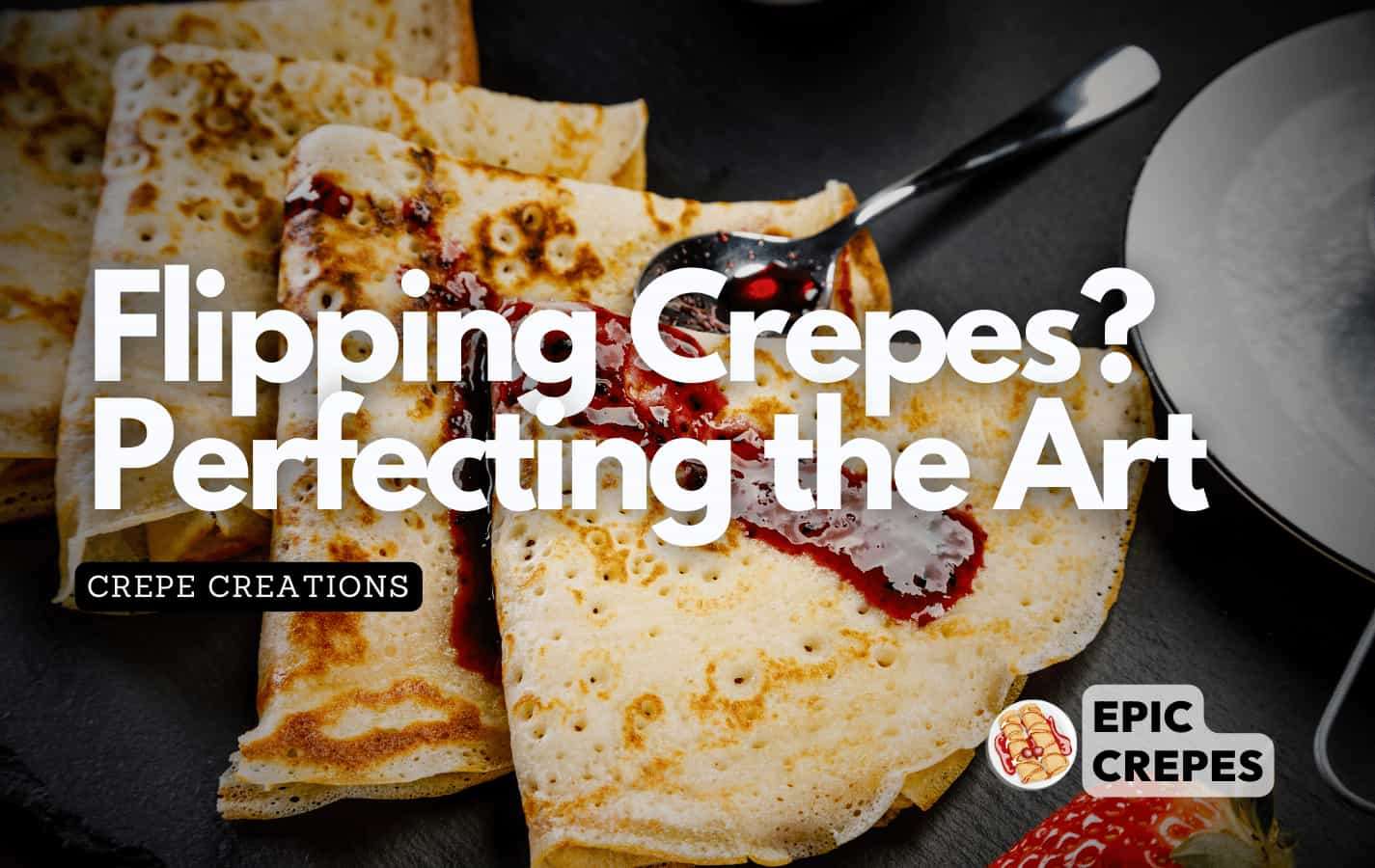Do you flip crepes? It’s a question that may seem trivial to some, but for those who take their crepe-making seriously, it’s a debate that can cause quite a stir in the kitchen.
Some argue that flipping crepes is necessary for achieving the perfect texture and even cooking on both sides, while others swear by leaving them untouched to avoid any mishaps.
For those unfamiliar with crepes, they are thin pancakes made from a batter of flour, eggs, milk, and butter. They originated in France and have since become a popular breakfast item around the world.
However, the technique for cooking them varies depending on who you ask. So, let’s dive into this age-old debate and explore whether or not you should be flipping your crepes.
The Art Of Crepe Making: A Brief History
The art of crepe making is a delicate dance between batter and heat. Like a skilled ballerina, the chef must twirl and swirl the batter onto the griddle, coaxing it into a thin, lacy circle.
While French influence is strong in this culinary art form, global variations have created unique crepe styles that are enjoyed around the world.
Legend has it that crepes were first made in Brittany, France, in the 13th century. The thin pancakes were popularized by street vendors who would sell them filled with sweet or savory ingredients. Over time, they became a staple of French cuisine and eventually spread to other parts of Europe and beyond.
Today, crepes come in all shapes and sizes, with flavors ranging from classic butter and sugar to more exotic combinations like goat cheese and figs.
Despite their many variations, one thing remains constant: the debate over whether or not to flip them during cooking.
Flipping Vs. Not Flipping: The Great Debate
Flipping crepes is a technique that many people swear by when making this delicate dish, but it also has its drawbacks.
One of the main benefits of flipping is that it allows you to cook both sides evenly and achieve a nice golden color on each side. However, flipping can be tricky and there’s always a risk of the crepe breaking or folding over on itself.
On the other hand, not flipping your crepes can also have its advantages. By only cooking one side of the crepe, you can achieve a softer texture and maintain the thinness of the batter. This method can also be easier for beginners or those who are not as comfortable with flipping.
Ultimately, whether to flip or not comes down to personal preference and skill level. It’s important to experiment with both methods and see what works best for you and your desired outcome.
- Flipping benefits:
- Evenly cooked on both sides
- Achieve a nice golden color
- Flipping drawbacks:
- Risk of breaking or folding over
- Tricky technique
In conclusion, there’s no right or wrong way to make crepes when it comes to flipping. Both methods have their benefits and drawbacks, so it’s up to you to decide which one you prefer. Don’t be afraid to try both techniques and see what works for you! Now, let’s move on to some tips and tricks for perfecting your crepe-making skills.
Tips And Tricks For Perfect Crepes
As we discussed in the previous section, there are differing opinions on whether to flip crepes. But what about the question of fillings? Some may argue that sweet fillings like Nutella and fruit are the best, while others prefer savory options like ham and cheese. Ultimately, it comes down to personal preference.
However, no matter what filling you choose, troubleshooting techniques can come in handy when cooking crepes. If your crepes are turning out too thick or lumpy, try adjusting the temperature of your pan or adding more liquid to your batter. And if they’re tearing or sticking to the pan, make sure you’re using enough butter or oil and gently loosening them with a spatula before attempting to flip.
Now that you have some tips for perfecting your crepes, why not explore alternative cooking techniques? While traditional stovetop cooking is popular, some adventurous chefs might try making crepes on a griddle or even in a waffle iron for a unique twist on this classic dish. The possibilities are endless!
Exploring Alternative Cooking Techniques
Alternative Cooking Techniques for Crepes
Cooking crepes can be quite an exciting experience, particularly when trying out different cooking techniques. Apart from flipping the crepes manually, there are other alternative ways to cook them. Here are a few pan alternatives that you can try:
- Electric Crepe Maker: This is a fantastic option if you want perfectly round and evenly cooked crepes without putting in too much effort.
- Non-Stick Skillet: A non-stick skillet can also come in handy as it allows you to cook your crepes evenly while preventing them from sticking to the pan.
- Cast Iron Skillet: If you’re looking for a more rustic approach to making crepes, then using a cast iron skillet might just be what you need. It’s perfect for creating crispy edges and giving your crepes a lovely golden brown color.
Now that we’ve explored some alternative cooking techniques let’s talk about crepe fillings. It’s no secret that crepes are incredibly versatile and can be filled with pretty much anything your heart desires. Here are some delicious ideas:
- Sweet Fillings: Nutella, strawberries and whipped cream, bananas foster, lemon curd
- Savory Fillings: Ham and cheese, spinach and feta cheese, mushrooms and onions, chicken alfredo
Incorporating these fillings into your crepe recipes will take your culinary skills to new heights! Don’t be afraid to experiment with different combinations until you find the perfect filling that suits your taste buds.
In summary, there are several alternative cooking techniques for making perfect crepes besides flipping them manually. Additionally, exploring different fillings is an excellent opportunity to add unique flavors and textures to your dish. So go ahead and start experimenting with these ideas – bon appétit!
Frequently Asked Questions
What Is The Nutritional Value Of Crepes?
Crepes may seem like a decadent treat, but with the right preparation and toppings, they can be a healthy alternative to traditional breakfast options.
One figure of speech that comes to mind is ‘you are what you eat,’ emphasizing the importance of choosing nutritious ingredients.
Crepes are typically made with flour, eggs, and milk, providing a source of protein and calcium. To make them even healthier, try using whole wheat flour and almond milk instead.
As for toppings, opt for fresh fruit or nut butter instead of sugary syrups. By making these small adjustments, you can enjoy a delicious and nutritious meal.
How Long Do Crepes Typically Take To Cook?
When it comes to cooking crepes, there are a few tips and tricks that can be helpful for ensuring they turn out just right.
One important tip is to make sure your pan is properly heated before adding the batter, as this will help prevent sticking or uneven cooking.
Once the batter is in the pan, try not to move or disturb it too much – this can cause tearing or uneven browning.
Instead, wait until the edges of the crepe start to lift slightly before gently flipping it over with a spatula.
If you do encounter any issues while cooking your crepes, such as sticking or tearing, there are troubleshooting techniques you can try – such as adjusting the heat or using more oil in the pan.
Overall though, with a bit of practice and patience, anyone can learn to cook perfect crepes every time!
What Is The Best Type Of Pan To Use When Making Crepes?
Hey there, are you ready to flip out over some crepes?
When it comes to making the perfect crepe, choosing the right pan can make all the difference.
Non-stick pans are generally easier to work with and require less oil, while cast iron pans distribute heat more evenly and add a delicious crispiness to your crepes.
As for gas vs. electric stovetops, gas provides more precise temperature control, but electric is often more convenient for beginners.
So whether you’re a seasoned chef or just starting out, finding the perfect pan for your crepes is key to achieving that coveted thin and delicate texture.
Can Crepes Be Made Gluten-Free?
Gluten-free alternatives for making crepes are available, allowing those with gluten sensitivities to enjoy this delicious dish. Substitute regular flour with gluten-free flour blends or almond flour to create a similar texture and taste.
There are also numerous flavor variations to experiment with, such as sweet options like Nutella and fruit, or savory fillings like ham and cheese. With these gluten-free alternatives and flavor variations, anyone can enjoy the French classic without sacrificing taste or dietary restrictions.
What Are Some Common Fillings For Sweet And Savory Crepes?
When it comes to crepes, the options for fillings are endless. From sweet to savory, traditional to modern, there’s a crepe filling for everyone.
Symbolically speaking, crepes can be seen as a blank canvas ready to be filled with whatever delights your taste buds desire.
Some common sweet fillings include Nutella and banana or strawberries and whipped cream. For savory options, try ham and cheese or spinach and feta.
Whether you prefer classic fillings or more contemporary ones, there’s no denying that crepes are a versatile dish that can be enjoyed any time of day.
Conclusion
In conclusion, crepes are a versatile and delicious dish that can be enjoyed any time of day. Their nutritional value varies depending on the ingredients used, but they can be a good source of protein and fiber.
When cooking crepes, it is important to use the right type of pan to ensure they cook evenly and don’t stick. One common idiom that comes to mind when discussing crepes is ‘flip it.’ While it may seem simple, flipping a crepe takes practice and skill. It’s important to have confidence in your technique and not be afraid to give it a try.
Whether you prefer sweet or savory fillings, there’s no denying that a well-made crepe is a culinary delight that everyone should experience. So go ahead and flip those crepes with ease!




